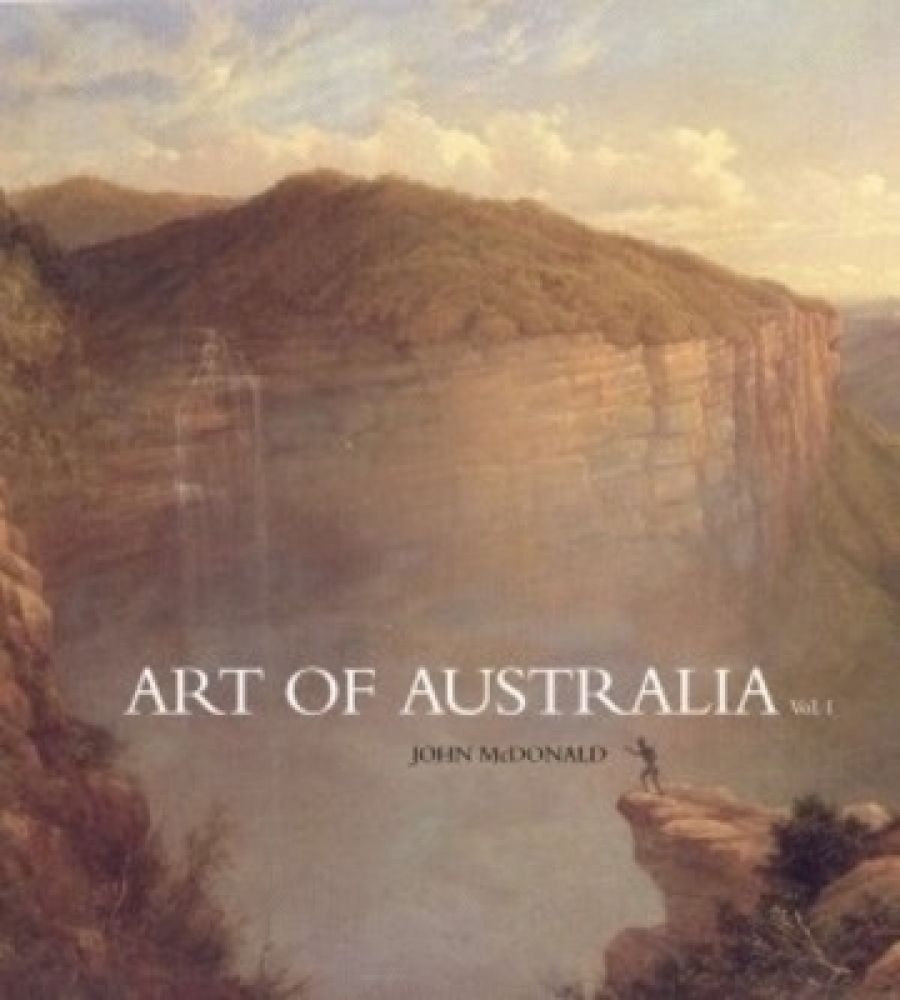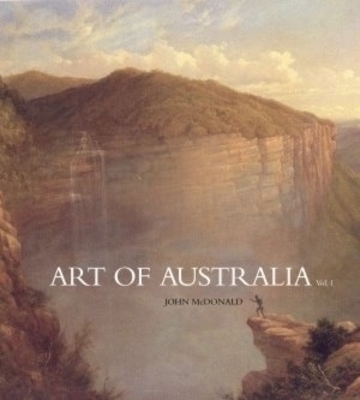
- Free Article: No
- Contents Category: Art
- Review Article: Yes
- Article Title: Bold claims and paradoxes
- Online Only: No
- Custom Highlight Text:
If the back-flap biography did not proclaim John McDonald as ‘Australia’s premier arts commentator’, if the author himself did not describe The Art of Australia in the preface as ‘a massive work of synthesis intended to bring together the most recent scholarship’, and if it were not being puffed in advertisements as ‘destined to take its place as the definitive work on Australian art’, one might be inclined to take this book on its merits.
- Book 1 Title: The Art of Australia, Volume 1
- Book 1 Subtitle: Exploration to Federation
- Book 1 Biblio: Macmillan, $125 hb, 656 pp, 9781405038690
- Book 1 Cover Small (400 x 600):

- Book 1 Cover (800 x 1200):

McDonald displays the combative instincts of the newspaper journalist, as when he objects – quite rightly – to the inclusion of Jane Sutherland in the National Gallery of Victoria’s Australian Impressionism exhibition (2007) as a ‘brazen attempt to catapult a woman artist into the art historical “big time”’. More often, however, the choler is expressed in uninflected put-downs, such as his description of Thomas Clark’s Ulysses and Diomed capturing the horses of Rhesus, king of Thrace as ‘a woeful slab of neoclassical schmaltz’, or his dismissal of E. Phillips Fox’s The landing of Captain Cook – one of a fascinating set of historical retrospects by Joseph Backler, Samuel Calvert, Marshall Claxton, Nicholas Habbe, Charles Hunt, William Macleod and others, which reveal profound things of nineteenth-century attitudes to foundation myths – as ‘a lame costume piece’.
Herein lies the book’s fatal flaw. It is the work of a journeyman critic pretending to the dignity of kunstwissenschaft. Indeed, in its sheer physical bulk (it weighs in at over 3.7 kilograms), as well as in the preface and various asides throughout, Art of Australia is clearly an attempt to supersede all previous general histories of settler art in this country, particularly those of Bernard Smith (1962), Robert Hughes (1966), Christopher Allen (1997) and Andrew Sayers (2001). Yet these predecessors, however constrained by the limitations of then-current art-historical understanding, or by the length and format dictated by a Thames & Hudson or OUP series format, show an intellectual and structural reach which is beyond McDonald. What we have here is simply a sequence of potted biographies of colonial painters, with several excursions into colourful social history – gold-rush politics, bushranging, Burke and Wills – followed by an extended survey of late nineteenth-century Australian naturalism, which is geographically and temporally confusing and unashamedly partisan (Charles Conder is the great hero, Fred McCubbin the plodding also-ran), with a tacked-on postscript of regionalism and Aboriginality.
Sure, at first glance it looks like art history. But look closer. There are 636 footnotes, but nearly all of them reference secondary texts. The index is quite alarmingly short. mostly comprises artists’ names, and does not even have italicised numbers to denote a reproduction (the pictures in this picture book are aggravatingly hard to locate). The five-page bibliography is most impressive, until you notice the gaps: where is Michael Dunn on Girolamo Nerli, or Patricia Fullerton on Ellis Rowan? Where is Eve Buscombe on colonial portraiture, Caroline Jordan on women amateurs, Anita Callaway on visual ephemera, Helen Ennis on photography? Apropos photography, how can we have four pages and five reproductions of Fred Kruger’s Corranderrk photographs but no reference to Jane Lydon’s Eye Contact? The literary tone lacks gravitas. While McDonald often shoots for the Hughesian witticism, the effect is usually both forced and anachronistic. Ned Kelly, in his iron mask, is ‘the ancestor of every monster of popular culture, every science-fiction robot and cyborg, from James Whale’s Frankenstein to Schwarzenegger’s Terminator’, while Lucien Henry’s allegory of New South Wales, in the Sydney Town Hall, ‘would look at home on the cover of a pulp “sword and sorcery” novel’. Describing the extravagant official mourning for Burke and Wills, McDonald ignores the meaningful parallel with the funeral of Prince Albert the year before, preferring to compare Melbourne’s public grief to that which followed the rather more recent death of Princess Diana, possibly in order to be able to use the gratuitously waspish and not particularly funny ‘at least they [Burke and Wills] were spared a musical tribute from Sir Elton John’.
The book’s scholarly pretensions and credibility are finally undone by the unremitting parade of error. McDonald is not a working art historian, so it is perhaps understandable that he should carelessly reiterate information which has been revised or refuted since its initial publication: the supposed loss of John Lewin’s first edition of Birds of Australia in a warehouse fire, for example; or Joseph Lycett tearing open his wounded throat rather than be returned to New South Wales; or John Glover’s familiarity with the London connoisseur Dr Thomas Monro.
Less acceptable are the lazy mistakes or misreadings. According to McDonald, Benjamin Duterrau sought employment in Van Diemen’s Land with ‘one of the wealthy families’ (actually at Hannah Clark’s ladies’ school, Ellinthorp Hall); Lake St Clair is in the north-east of Tasmania (it’s pretty much dead centre); and Sydney Aboriginal leader Bungaree participated in three voyages of exploration (four, in fact). Writing of Eugene von Guérard ‘s Tower Hill of 1855, he describes how the artist ‘had been appalled by his first sight of the lake’, and had described it as ‘a stinking mud pool’, whereas the quotation he cites (inaccurately) is from von Guérard’s patron James Dawson, and dates from 1891, when the Tower Hill environment had indeed become seriously degraded.
At one point, McDonald does explain his cavalier attitude to the facts, in what reads surprisingly like a conversion to postmodernity: ‘Few historians still subscribe to the view that their discipline is best approached as a science in which facts are collected and given an objective evaluation. For better or worse, history is always a form of literature, laden with rhetorical devices.’ So are we entitled to bend the truth to fit our literary conceits? While it is certainly true that the best history demands imagination, literacy, and the occasional deployment of rhetorical devices, it also demands a substantial investment in empirical evidence, whether of greater or lesser reliability.
But in this McHistory you don’t even have to look at things properly. While ornithological innocence might explain the identification of the ibises in the foreground of W.C. Piguenit’s The flood on the Darling as herons, the description of the figures on the pier in Conder’s Holiday at Mentone as ‘a man, two women and a small girl’ is simply wrong: the ‘girl’ is actually another woman, who appears shorter than her companions because she is seated on a bench. Describing Arthur Loureiro’s The spirit of the new moon, McDonald writes of how ‘a crazed-looking God, with hair and beard protruding in every direction, reaches menacingly out of the clouds …’ There is no such figure in the painting at all; it is in an earlier study, The spirit of the storm.
In closing, as is traditional in reviews of books such as this, I must include partisan complaints about who has been unfairly excluded. And indeed, when there are seven reproductions of works by John de Mansfield Absolon, six by W.B. Gould, five by Isaac Walter Jenner, four by George Peacock and three by Karl Kahler, why have so many artists missed out completely? The treatment of sculpture and photography is cursory at best, while printmaking (apart from the tedious design conceit of over enlarged details from the Picturesque Atlas of Australasia) is almost invisible. Some not only fail to get an illustration, they are not mentioned at all. Where are all those other colonial portraitists: Backler, William Paul Dowling, Conway Hart, William Nicholas, Richard Noble, Henry Mundy? Where are the women: Sophia Campbell, Harriet and Helena Scott, Theresa Walker, Georgiana McCrae? Where are Henry Burn, C.H.T. Costantini, John Lhotsky, Henry Rielly?
All these issues could and indeed should have been addressed in the commissioning and editing process. Proper refereeing by informed academic readers would have ensured the excision of the more egregious errors in the body of the text, and might even have suggested useful alternative dynamics, weighting or imagination in the selection and interpretation of images. An alert copy editor would have ensured that the picture captions were consistent in format, and that the many spelling errors and typos were at least minimised. More attentive editing might also have picked up that one of the Kahler reproductions is repeated, in a different size and over another title. More importantly, it could also have eliminated the common and extraordinarily frustrating experience of having an artist or a work introduced or described at some length in the text, but not illustrated.
Actually, this last could stand as the symbol of The Art of Australia’s paradox and failure. The Big, Important History of Australian Art is described or implied in all this volume’s weight and shape and gloss and self-regard, but, sadly, such a book is here nowhere to be found.


Comments powered by CComment